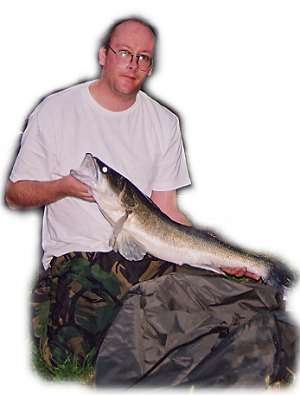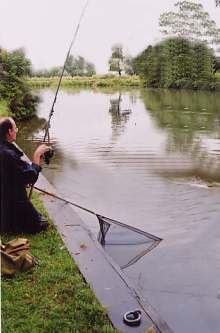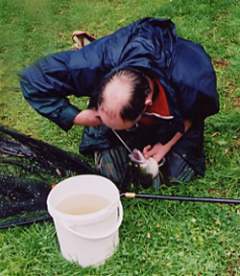We’ve looked at how zander have spread through East Anglia and theMidlands, after being stocked into Norfolk’s Relief Channel.
We’ve also looked at tooling up for river fishing, with simpletrotting gear. Now it’s time to put it into practice – and hopefullycatch a few.
|
|
| in the shape of 10lb 7oz zander |
All you need to get the best from the basic trotting rigs weoutlined last time is a grasp of how zander feed. It might look likescaled-down pike fishing but the two are worlds apart. While thereare fewer hard and fast rules as far as zander are concerned, thereare still enough certainties to give you some short cuts when itcomes to finding them and getting them to take the bait. One is thatup to a certain size, they’re a shoal fish which hunts in packs.Another is that they are highly mobile, ranging far and wide insearch of food.
Dusk seems to trigger a feeding spell on most waters, although thezander’s iridescent eyes enable them to see in extremely low lightconditions and they can and do feed right through the night. Dawncan also be one of the most productive times, while to furtherconfuse things you can also catch them in broad daylight. Regardlessof the time or day or night, locating the zander’s prey orsecond-guessing their patrol routes is the key to catching them.
Find their food source and the zander will usually be along sooneror later
– if they aren’t already nearby.
Finding the fodder fish is easiest at dawn and dusk, whenhand-sized silver fish usually often give their presence away withsurface activity. If roach and bream anglers are still on the waterwhen you arrive, it’s worth checking which lines they’ve beenbaiting.
Club and open matches can be a goldmine if nets full ofdisorientated roach and skimmers have been tipped back into themargins after the weigh-in. In the absence of assistance from thewould-be Bob Nudds of this world, you’re going to have to make aneducated guess. Heading for bends, bridges, marina entrances, linesof moored boats or deeper areas are usually a safe bet, because allare either favoured by prey shoals or they provide the zander withthe cover they instinctively seek between hunting trips. Exploringthe stretch of river between a prey shoal and a resting-up spot – themost obvious patrol route going – and you should be ideally-placed tonab a few once they begin hunting for food. At dusk, start trottingthe middle of the river, working the bait into the margins around theedges of the prey fish as it gets dark. Zander can literally becaught right under your rod top on the Fenland rivers, which tend tohave deep margins filled with cabbages and lilies.
|
|
| |
At dawn, try just over the marginal shelf, working out to thedeeper water in the middle of the river as it gets light. Fishingtight to features which shade the water – like bridges, moored boatsetc – can also work as day breaks. I don’t bother plumbing the depth,I’m too worried the disturbance could scare off fish already in thevicinity.
Make a rough guess at mid-water instead and deepen up a foot ortwo every couple of trots until you find the taking depth or the baitstarts dragging weed or the bottom. The taking depth can literallyvary from hard on the bottom by day to just under the surface atnight, depending on what the prey are doing. As the bait trotsthrough, stop it and straighten the line behind the float every 10 or15 yards.
With practice, you can draw the line tight with the rod top, sothe bait rises up towards the surface. Takes often come as itflutters back down again, like an injured prey fish. With deads youcan increase the effect by moving the weight higher up the trace,away from the bait, to increase the time it takes to sink back downagain. Half a dozen casts – say half an hour – should produce a takeif the fish are there. Unless there’s an obvious feature which meritsa more thorough work-out, it’s worth moving if you’ve trotted 100yards or so of river trying different depths without so much withoutso much as a sniff. Easy if all you’ve got to carry is a rod, net,bucket and a few bits and pieces slung in a small rucky or shoulderbag.
When you do find the fish, you’ll soon find out why we favourfloat fishing. As well as enabling you to search the riverthoroughly, floats are far more “chatty” than bite alarms. They giveyou a much clearer idea of what’s going on at the other end.
Unlike the pike, which grabs and swallows its prey in a singlerush, zander often kill live prey before coming back to finish thejob. A hunting pack of smaller fish will sometimes hit a shoal ofprey, snapping at anything within reach, before returning to mop upthe dead and walking wounded injured in the initial rush. The floatlifts as the zander chases the bait and bobs sharply as it attacksit, before resuming its trot. When this happens, tighten down gentlyand wait. Nine times out of 10, a fish will come back if the currentdoesn’t drag the bait away from the shoal. On other occasions, thefloat will bob and dance, shooting to and fro half way across theriver. When this happens, it’s almost certain smaller fish areresponsible, with two of them fighting over the bait before one getshold of it and darts away from the rest of the shoal to finish it inpeace. Either way, you’ll hook a lot more if you wait until the floatgoes down and stays down, with the line tightening, before you winddown and bend into them. Obviously we’re talking a few seconds here,not so long that a fish has a chance to swallow the bait.
|
|
| |
A more confident take, where the float just disappears, invariablymeans a bigger zander capable of overwhelming the bait and gulping itdown without stopping, or even a pike.
Miss one and you’ll usually find the zander’s four front teethhave left deep slashes down the bait’s flesh. If this happens, tryhooking the bait head-up the trace, with the top treble through thetop lip and the bottom hook nicked in the root of the ventral fin orthe belly. Zander will often attack prey from the tail, perhaps todisable their propulsion before the coup de grace. You’ll miss plentyand bump off even more in the first few seconds until you get thehang of it. When this happens, just console yourself that at leastyou’ve found them.
Through-the-middle floats are an easier option when it comes totrotting moving water, because they don’t get pulled under or draggedoff course as you straighten the line. But they have their downside.Pull into a take and you’ve got to pull through the float, with allthe disturbance that entails, before you can feel if there’s anythingon the end. If you’re fishing deep, it takes a firm pull to connect,even with a slider. Time it wrongly and miss one and you riskspooking the shoal. Waggler-style floats are harder to get the hangof but they have the advantage of folding flat when you tighten theline, meaning you can wind down gently and feel for the fish. Ifthere’s nothing on the end open the bail arm, swing the rod tiptowards the float, and it’ll bob back up again, without scaring thezander away from you. Attach them via a link swivel and you canchange them instantly, to take account of differing flows or baitsizes – or swop a standard float for one with a light on top forfishing after dark.
Whoever said zander don’t fight..? You might be surprised when youget one on the end. Even a three pound schoolie feels a lot biggerwhen you first bend into it. The fight is usually a three-stageaffair, which starts with violent head shaking, followed by divingand trying to run for cover, followed by another violent display ofhead shaking as you draw the fish over the net. If you’re confidentin your hooks and traces, the best advice is bend in hard and hangon. Ease off as a fish starts head-banging and they’ll use even alittle slack to throw the hooks. I never found I landed more fishwhen I used softer rods and a gentler approach to playing them. Ialso found a lot more fish ended up rolling on the trace as theythrashed around, meaning kinked wire at the best of times and a loopof it round a fin or gill cover too often to be acceptable. Holdingthe rod up helps. If you try to bully them off the bottom, they throwtheir energies into trying to stay down, exhausting themselvesagainst the upward pressure. This can sometimes backfire when youhook a pike, bully it to the top and it tailwalks half way across theriver before throwing your hooks. C’est la vie I’m afraid. Once theysee the net, they always seem to find their second wind, so have thedrag set accordingly, or – better still – be ready to backwind.
|
|
| with the right gear and approach |
Unhooking them should be quick and easy if you’ve got the forcepsto hand. Unlike pike, which can be a handful until you get the hangof them, zander have a rough skin which is easy to grip. But thereare one or two things to beware of if you need to put the fish downto unhook it. Using an unhooking mat and making sure it can’t flapabout and injure itself, or roll back into the water is common sense.Rolling them onto their backs helps stop the spined dorsal finlacerating your hand, while their sharp gill covers also demandrespect. If you know where the hooks are, straddle the fish and slidea flinger into its gill slit, gently lifting its head – just as you’dunhook a pike. If you don’t know where the hooks are, check firstunless you want one in your finger. Once you have got the hooks out,the zander will often need a second or two to recover. Holding thefish in the landing net for a minute or two will help it get itsbreath back. Otherwise, hold it upright until the gills start pumpingand you can feel it start tensing up, ready to go on its way.
Once you’ve caught one, you’ll probably want to catch a few of itsmates. The trick is to stay in touch with the shoal as it moves upand down the river. My best-ever session treated 18 fish to five orsix pounds to a ride in the landing net until I ran out of baits.
The first was caught 100 yards or so downriver. They graduallycame closer until I lost what felt like a real lump and it all wentdead, until I started dragging the bait along the bottom and foundthe commotion had made them drop back down the swim into a deeperrun. Keep trying different depths. The more of them you catch, thecagier they get and they’ll often drop right down to the bottom onceyou’ve caught a couple. If they suddely disappear, try fishingfurther across, or move 50 yards up or downstream and try there.
I’ll admit this is fun fishing, chasing fish for the joy of it onan autumn evening, rather than setting out your stall for a big one.But they do come along from time to time, lending credence to theview bigger zander often shadow shoals of schoolies – perhaps for theeasy pickings they leave behind. While Rick and I were trying to fishto order and catch some zander to supplement our woeful picturelibrary, the float went down with a plop so loud it echoed off a lowbridge across the Great Ouse.
Instead of the expected double figure pike, we ended up admiring a10:8 zander – the biggest I’ve ever caught on the river. Zander bringa fresh set of challenges, whether you’re a dyed-in-the-wool pikerlooking for a bit of light relief, or you want to sample predatorfishing without the time and commitment piking demands. I hope you’llenjoy your zander and treat them with respect either way.
They don’t deserve any of the ill-treatment and hysteria that’sbeen dished out at times, ever since the first few dozen slipped awayinto the windswept waters of the Relief Channel.














